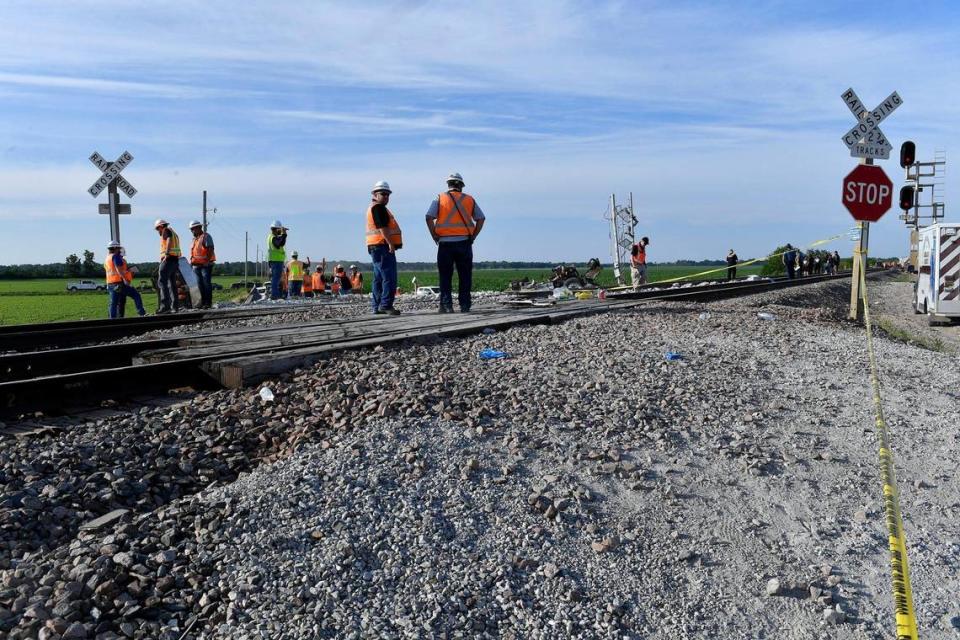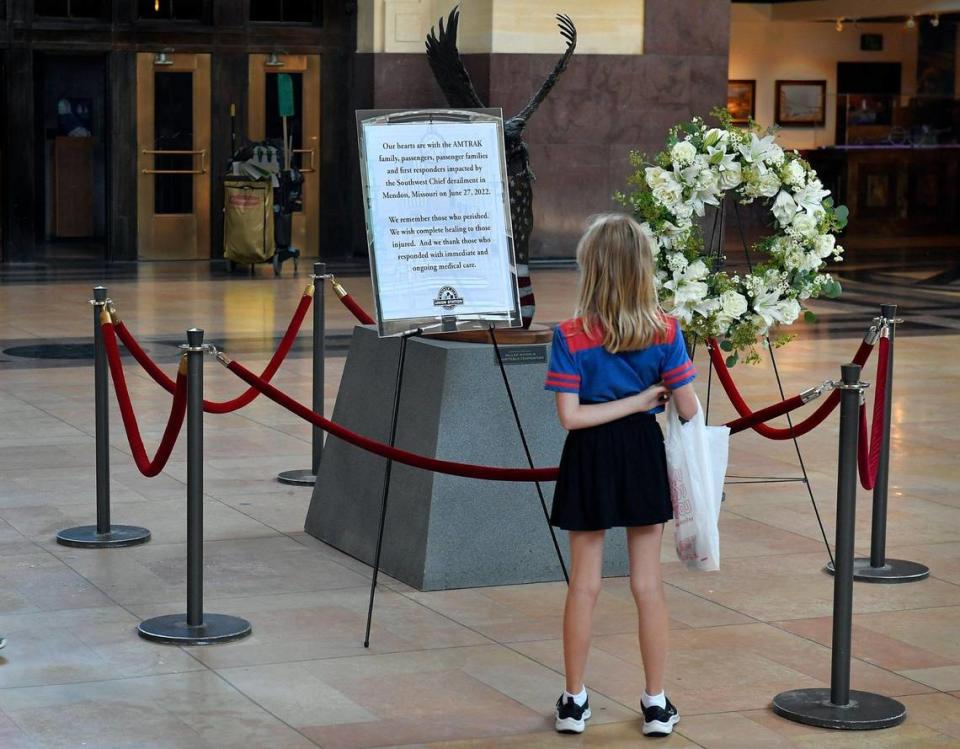‘This crossing shouldn’t even exist.’ Expert says Amtrak crash site was longtime hazard
When Bob Comer saw photos and videos of the railroad crossing where an Amtrak train crashed into a dump truck in northern Missouri on Monday, something immediately caught his eye.
The crossing, Comer said, is way too steep.
“It became extremely apparent that this is a really severe, what’s called humped or low ground clearance,” said Comer, a railroad crash expert who has investigated train wrecks for more than three decades. “It’s terrible.”
Four people were killed — three from the train and the truck driver — and about 150 injured when the train derailed after hitting the truck southwest of Mendon in Chariton County. As of Wednesday, 13 remained hospitalized. The train was traveling eastbound from Los Angeles to Chicago and carrying approximately 275 passengers and 12 crew members.
The Porche Prairie Avenue Crossing has stop signs but no warning lights, bells or cross arms, and residents in the area say they have complained for years that the grade was too steep and dangerous.
Despite those concerns, BNSF Railway, which owns the track, told The Star this week that the Missouri Department of Transportation had not — even up to the day of the crash — contacted them to conduct an official review of the site that is required before any repairs are initiated.
That came as a surprise to farmers in the area who after a March 2021 meeting at the crossing, where the state and county commissioners were present, expected repairs would soon occur there.
MoDOT in July 2021 placed the crossing on a priority list of those approved for improvements, but the agency — which is authorized by the Federal Railroad Administration to run the state’s railroad safety crossing program — hasn’t even begun the “diagnostic review” process required to get the project underway.
Comer said that’s unacceptable.
“The crossing has to be fixed to make it less steep,” he told The Star. Installing warning devices isn’t enough, he said.
“Even if they put lights and gates and bells there, that doesn’t fix the grade,” he said. “The approach on either side of the road could have been elevated, could have been brought up. If they’re not going to fix it, or raise the road, this crossing shouldn’t even exist. They should have just closed it.”

‘It was a preventable accident’
U.S. Rep. Sharice Davids told reporters Thursday that residents of the 3rd District, which she represents, have been impacted by the crash. She offered her condolences to those who lost loved ones or were injured.
“I know the circumstances of the crash are under investigation, but we do know that the derailment was in part due to the poorly signposted rail crossing,” said the Kansas Democrat, who is vice chair of the House Transportation and Infrastructure Committee. “It wasn’t a mechanical failure. It was a preventable accident.”

Jennifer Homendy, the National Transportation Safety Board chair who is in Missouri as part of a 14-member team investigating the crash, said at a news conference Wednesday that the train was traveling 87 mph when it hit the truck. The speed limit on the track at that crossing is 90 mph.
Homendy said investigators were examining the slope of the road at the crossing.
“We have to look at the approach to this crossing,” she said. “It is very steep. Very steep. Which really has an impact when you’re moving pretty heavy, large vehicles, or combines if you’re a farmer moving from field to field or to a farm.
“I understand that there are so many crossings in Missouri and that there are some that may be in more dire shape than this one. But this is the one I’m focused on right now, because people died.”
Missing sign
Another safety concern Comer said he spotted was the absence of a required sign warning motorists about the low ground clearance at the crossing.
The black and yellow sign depicts a truck stuck on a railroad crossing.
“What I’ve seen all over the United States is the railroads failing to put those low ground clearance signs on the posts at the crossing, which is their responsibility,” Comer said. “And they’re also required on the approaches to the crossing, which would be the responsibility of the county or the officials there.”

Chariton County Presiding Commissioner Evan Emmerich did not respond to a request for comment Thursday. And BNSF spokeswoman Lena Kent said in an email: “Given NTSB is investigating this incident, I cannot comment.”
The Federal Railroad Administration keeps records on all railroad crossings in the country. The records on file for the Porche Prairie crossing were updated on Tuesday.
According to the “inventory report,” the track’s primary operator is BNSF Railway Co. The average number of passenger trains that run on the track per day is two, the report says, and the average number of daily train movements in 2019 was 58 – 29 running from 6 a.m. to 6 p.m. and 29 operating from 6 p.m. to 6 a.m.
The report said the crossing had no bells, flashing lights or gate arms. But on the question as to whether the crossing had a low ground clearance warning sign, both the “yes” and “no” boxes were left unchecked.
Comer, who lives in Manhattan, Kansas, said the responsibility for the crossing may lie with more than one entity.
“All railroad crossings in the United States are owned by the railroad whose track goes through it,” he said. “But both the county or township or state and the railroad have kind of a combination of responsibility.”
The railroad owns the crossing, he said, but how much of the crossing it owns depends on how much right-of-way it has next to the track. If it’s a small amount, he said, the approach to the crossing may not be included, and the responsibility would fall on the county.
‘There hasn’t been any progress at all’
Paul Speichinger, who raises crops in fields adjacent to the railroad track, said the crossing has been a major concern in the community for years. He doesn’t want to see it closed, but said the overgrown brush along the track blocks drivers’ line of sight and needs to be cleared and the sharp incline reduced.
“It’s a very steep grade and over the years when they work on the rail, they have brought in more rock and it’s built up the rail bed more and it’s gotten a lot steeper,” Speichinger said. “It is difficult to climb the grade. You have to gear down and come up there to the tracks to be able to see if the rail is clear.”
He said residents who have complained about the crossing were relieved last year when they learned it was supposed to be fixed.
“We were told that it was a valid concern,” he said. “And it just looks like it has stopped in the water. There just hasn’t been any progress at all.”
Speichinger said his son was driving a combine down the gravel road near the crossing on his way to harvest wheat Monday when the crash occurred.
“He saw the cloud of dust there, and when he rounded the corner and came closer, only part of the train was on the tracks,” he said. “He was one of the first on the scene.
“It’s a sad situation that we had this many lives lost. And it all could have been avoided if we’d just had a safer crossing at that location. It’s a terrible, terrible deal.”
The Star’s Katie Bernard contributed to this report.

 Yahoo Movies
Yahoo Movies 
